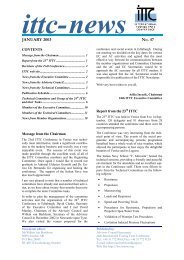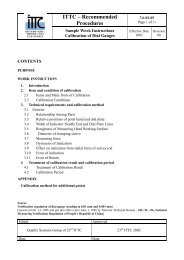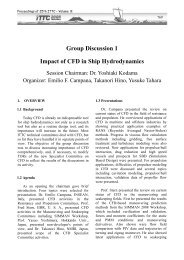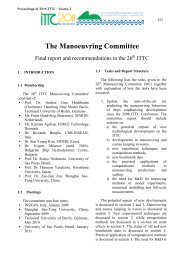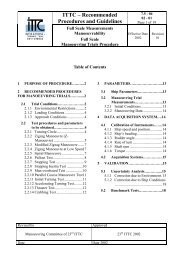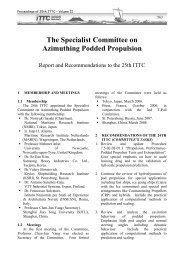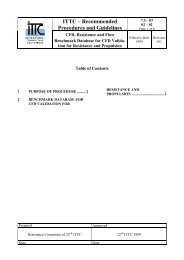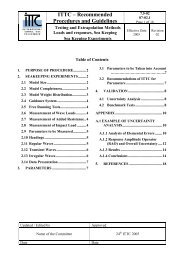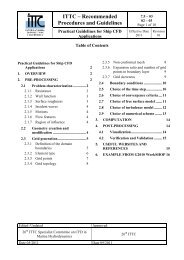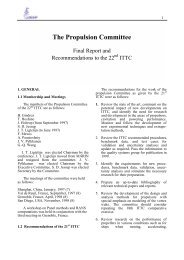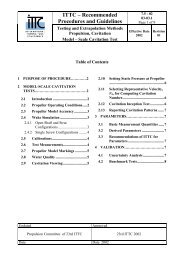The Specialist Committee on Vortex Induced Vibrations - LabOceano
The Specialist Committee on Vortex Induced Vibrations - LabOceano
The Specialist Committee on Vortex Induced Vibrations - LabOceano
Create successful ePaper yourself
Turn your PDF publications into a flip-book with our unique Google optimized e-Paper software.
Proceedings of 26th ITTC – Volume II561<str<strong>on</strong>g>The</str<strong>on</strong>g> <str<strong>on</strong>g>Specialist</str<strong>on</strong>g> <str<strong>on</strong>g>Committee</str<strong>on</strong>g> <strong>on</strong> <strong>Vortex</strong> <strong>Induced</strong>Vibrati<strong>on</strong>sFinal Report and Recommendati<strong>on</strong>s to the 26th ITTC1. REPORT FROM THE COMMITTEE1.1 Membership and Meetings<str<strong>on</strong>g>The</str<strong>on</strong>g> members of the <strong>Vortex</strong> <strong>Induced</strong>Vibrati<strong>on</strong>s <str<strong>on</strong>g>Specialist</str<strong>on</strong>g> <str<strong>on</strong>g>Committee</str<strong>on</strong>g> of the 26 thInternati<strong>on</strong>al Towing Tank C<strong>on</strong>ference are asfollows:• Halvor Lie, Dept. of OffshoreHydrodynamics, MARINTEK, Norway.(Chairman).• Elena Ciappi, Istituto Nazi<strong>on</strong>ale per Studied Esperienze di Architettura Navale(CNR-INSEAN), Italy.• Shan Huang, Naval Architecture andMarine Engineering, University ofStrathclyde, UK.• Sup H<strong>on</strong>g, Korea Ocean Research &Development Institute (KORDI), SouthKorea• Z<strong>on</strong>g Zhi, Department of NavalArchitecture and Ocean Engineering,Dalian University of Technology, ChinaThree committee meetings were heldrespectively:• CNR-INSEAN, Italy, November 2009• Shanghai (OMAE 2010), China, June2010• University of Strathclyde, Glasgow, UK,February 20111.2 Tasks and Recommendati<strong>on</strong>s of the 25 thITTC<str<strong>on</strong>g>The</str<strong>on</strong>g> original tasks of the 26th ITTC VIV<str<strong>on</strong>g>Specialist</str<strong>on</strong>g> committee recommended by the 25 thITTC were as follows.• Task 1. Update the state-of-the-art forpredicting vortex induced vibrati<strong>on</strong>s andmoti<strong>on</strong>s emphasizing developments sincethe 2008 ITTC in various current profilesat ultra deep water. <str<strong>on</strong>g>The</str<strong>on</strong>g> update shall coverboth small-diameter structures (e.g. risers)and large-diameter structures (e.g. SPARplatforms).• Task 2. Organize, c<strong>on</strong>duct and report theresults of benchmark VIV tests. Cooperatewith OMAE <strong>on</strong> the benchmark activity.• Task 3. Prepare standard nomenclature forVIV and VIM investigati<strong>on</strong>s.• Task 4. Write a procedure for VIV andVIM testing for marine applicati<strong>on</strong>s.1.3 Brief Descripti<strong>on</strong> of the Executi<strong>on</strong> of theTasksTask 1. <str<strong>on</strong>g>The</str<strong>on</strong>g> review is presented in thefollowing chapters.Task 2. <str<strong>on</strong>g>The</str<strong>on</strong>g> benchmark study had initiallyseven participating institutes. However duringthe 26 th ITTC period two of them withdrewtheir participati<strong>on</strong> and two others of the
<str<strong>on</strong>g>The</str<strong>on</strong>g> <str<strong>on</strong>g>Specialist</str<strong>on</strong>g> <str<strong>on</strong>g>Committee</str<strong>on</strong>g> <strong>on</strong> <strong>Vortex</strong> <strong>Induced</strong> Vibrati<strong>on</strong>s562participants reported unforeseen delay.<str<strong>on</strong>g>The</str<strong>on</strong>g>refore results from <strong>on</strong>ly three participantswere reported to the committee in the end ofspring 2011, which was c<strong>on</strong>sidered to be toosparring for the benchmark study. <str<strong>on</strong>g>The</str<strong>on</strong>g>committee therefore recommends ITTC toc<strong>on</strong>tinue and complete the Benchmark study inthe next ITTC period.Task 3. A nomenclature is included in thereview.Task 4. <str<strong>on</strong>g>The</str<strong>on</strong>g> committee has made a draftversi<strong>on</strong> of a guide line (GL) and recommendsthat the GL should be completed during thenext ITTC period.2. REVIEW2.1 Numerical ModelsMost of the work d<strong>on</strong>e in last three yearsc<strong>on</strong>cerning the VIV resp<strong>on</strong>se of isolated rigidcylinders free to oscillate in 1 or 2 DOF and offlexible cylinders was devoted mainly toimprove the predicti<strong>on</strong> capabilities of wakeoscillator models rather than to thedevelopment of new CFD or semi-empiricalmodels.In fact, a significant number of thepublished papers describe very sophisticatedwake oscillator able to capture the n<strong>on</strong>linearmulti-mode dynamics and interacti<strong>on</strong>s offlexible curved or straight structuresundergoing VIV and to overcome the limitati<strong>on</strong>of previous models in predicting the amplitudeof oscillati<strong>on</strong>s.Much less CFD analyses have been d<strong>on</strong>erecently. All the traditi<strong>on</strong>al computati<strong>on</strong>alapproaches have been adopted for the flowdescripti<strong>on</strong> including Direct NumericalSimulati<strong>on</strong>s (DNS), RANS methods, LESmodel and Detached Eddy Simulati<strong>on</strong> (DES)using finite difference, finite volume and finiteelement scheme. In particular several authorsproposed space-time finite element as a validtool to solve fluid-structure interacti<strong>on</strong>problems with moving boundaries such as VIVof an elastic cylinder and to improve thec<strong>on</strong>vergence rate in iterative soluti<strong>on</strong> of thelarge scale n<strong>on</strong>-linear equati<strong>on</strong> system.Structural analyses are performed usingfinite element, finite difference and modalanalysis.Most of the numerical simulati<strong>on</strong>s are twodimensi<strong>on</strong>alor, making use of the strip theory,quasi-three dimensi<strong>on</strong>al.Notwithstanding, 3D simulati<strong>on</strong>s of theVIV resp<strong>on</strong>se of flexible risers with highaspect ratio and at moderately high Reynoldsnumber (up to 1.5x10 4 ) in uniform and shearedcurrent can be found and seem to agreesatisfactorily with experimental data.Existing CFD codes have also been appliedto the study of the efficacy of VIV suppressi<strong>on</strong>devices. For the semi-empirical models, thework recently d<strong>on</strong>e is focused <strong>on</strong> theenhancement of existing codes to overcomesome of the shortcomings of previous methods,<strong>on</strong> the benchmarking of different tools and <strong>on</strong>their validati<strong>on</strong> with comparis<strong>on</strong>s with modeland full-scale experimental data.On the other hand, c<strong>on</strong>siderable interest hasreceived in last years the numerical study of theflow around multiple cylinders usingprincipally DNS for the flow field descripti<strong>on</strong>.However, up to date, results are available <strong>on</strong>lyfor low Reynolds numbers (Re
Proceedings of 26th ITTC – Volume II563periodically forced oscillati<strong>on</strong> and a selfexcitedoscillati<strong>on</strong> both at c<strong>on</strong>stant amplitudeand the influence of the Reynolds number <strong>on</strong>the vortex-shedding modes. <str<strong>on</strong>g>The</str<strong>on</strong>g> study isperformed by using a 2D LES with aSmagorinsky model to simulate uniform flowspast a circular cylinder oscillating at modulatedfrequency for a Reynolds number rangebetween 500 and 8000. With regards to l<strong>on</strong>griser simulati<strong>on</strong>s, He et al. (2010) simulate theVIV of a flexible riser with aspect ratio equalto 250 for Reynolds numbers up to 1.28x10 4using Finite Element for the structure andFinite Volume for the fluid domain. <str<strong>on</strong>g>The</str<strong>on</strong>g> modelis based <strong>on</strong> strip theory which assumes that theflow is locally 2D due to the correlati<strong>on</strong> oflock-in effects. <str<strong>on</strong>g>The</str<strong>on</strong>g>y found that the in-line andcross-flow moti<strong>on</strong> are str<strong>on</strong>gly coupled andexhibited similar behaviour for particularvalues of the reduced velocity. Moreover,Huang et al. (2009a, 2009b) presented 3Dnumerical simulati<strong>on</strong>s of the moti<strong>on</strong> of aflexible riser (L/D=482) in uniform andsheared current, respectively. <str<strong>on</strong>g>The</str<strong>on</strong>g> time domainsimulati<strong>on</strong>s are performed using the FiniteAnalytic Navier-Stokes (FANS) code. <str<strong>on</strong>g>The</str<strong>on</strong>g>flow field around the riser is calculated solvingthe unsteady, incompressible 3D Reynolds-Averaged Navier-Stokes (RANS) inc<strong>on</strong>juncti<strong>on</strong> with a large eddy simulati<strong>on</strong> (LES)model for Reynolds numbers between 7.5x10 3and 1.5x10 4 . <str<strong>on</strong>g>The</str<strong>on</strong>g> moti<strong>on</strong> of the riser ispredicted through a tensi<strong>on</strong>ed beam equati<strong>on</strong>with structural damping. <str<strong>on</strong>g>The</str<strong>on</strong>g> numerical resultsagree satisfactorily with experimental data bothfor the in-line and cross-flow moti<strong>on</strong> and forthe sheared current case a fatigue life analysisis performed.Wanderley et al. (2008) used the Roe-Swebe scheme to solve the slightlycompressible 2D RANS equati<strong>on</strong>s and the k-turbulence model to simulate the turbulent flowin the wake of a circular cylinder. <str<strong>on</strong>g>The</str<strong>on</strong>g> aim ofthe paper was to duplicate numerically theexperiments of Khalak and Williams<strong>on</strong> (1996).<str<strong>on</strong>g>The</str<strong>on</strong>g> results achieved agreed very well withexperimental data and dem<strong>on</strong>strated the abilityof this methodology in predicting correctamplitudes in the entire range of reducedvelocity for the low mass ratio case.Prasanth and Mittal (2008) presentednumerical simulati<strong>on</strong> of VIV of a circularcylinder of low n<strong>on</strong>-dimensi<strong>on</strong>al mass in thelaminar flow regime (60
<str<strong>on</strong>g>The</str<strong>on</strong>g> <str<strong>on</strong>g>Specialist</str<strong>on</strong>g> <str<strong>on</strong>g>Committee</str<strong>on</strong>g> <strong>on</strong> <strong>Vortex</strong> <strong>Induced</strong> Vibrati<strong>on</strong>s566element program ABAQUS is used to modelthe riser for the generati<strong>on</strong> of modal parameters.<str<strong>on</strong>g>The</str<strong>on</strong>g>y investigated the sensitivity of the resultsto the type of lift coefficients, mode bandwidth,mode cut-off and the Strouhal number usingdifferent versi<strong>on</strong> of the program. In additi<strong>on</strong>they compared the results obtained bySHEAR7 with those by ABAVIV obtaininggood agreement both in terms of fatiguedamage variati<strong>on</strong> al<strong>on</strong>g the riser and mostdamaging locati<strong>on</strong>. In the paper of Tognarelliet al. (2009) BP's benchmarking of differentversi<strong>on</strong> of SHEAR7 is described. In particularcomparis<strong>on</strong>s are made between predicted andmeasured VIV fatigue damage for several fullscaledrilling risers to dem<strong>on</strong>strate the efficacyof a calibrati<strong>on</strong> for the latest versi<strong>on</strong>. <str<strong>on</strong>g>The</str<strong>on</strong>g>yfound that while the predicti<strong>on</strong>, <strong>on</strong> average, aresimilar, the scatter in predicti<strong>on</strong>s which leadsdesigners to large factor of safety is notreduced from versi<strong>on</strong> to versi<strong>on</strong>. Thus, theyrecommended to obtain more measured, fullscaleVIV fatigue and current data for bettercalibrati<strong>on</strong> and development of VIV fatigueanalysis methods and to c<strong>on</strong>siderimproved/new analysis models that will reducepredicti<strong>on</strong> scatter.A new stochastic model for predicti<strong>on</strong> offatigue damage from VIV in risers is developedand implemented in VIVANA (Lie et al.,2008). As in the original model the structuralmodel applies a n<strong>on</strong>-linear 3-D FE whichmakes it able to work with an arbitrarydistributi<strong>on</strong> of tensi<strong>on</strong>, mass, stiffness,buoyancy and diameter. Resp<strong>on</strong>se frequenciesare identified while c<strong>on</strong>sidering a frequencydependent hydrodynamic mass al<strong>on</strong>g thestructure. Resp<strong>on</strong>se amplitudes are calculatedat the discrete frequencies by the frequencyresp<strong>on</strong>se method. <str<strong>on</strong>g>The</str<strong>on</strong>g> excitati<strong>on</strong> force modelincludes a lift coefficient that is a functi<strong>on</strong> ofthe resp<strong>on</strong>se amplitude and the resp<strong>on</strong>sefrequency.<str<strong>on</strong>g>The</str<strong>on</strong>g> new method overcomes some of theshortcomings of previous methods. A fully 3Dmodel is implemented, 3D (n<strong>on</strong>-uniform)current c<strong>on</strong>diti<strong>on</strong>s can be analyzed, “crossflow”(CF) and “in-line” (IL) resp<strong>on</strong>se arepredicted and the stochastic nature of theresp<strong>on</strong>se is accounted for. This is d<strong>on</strong>e byintroducing a time varying envelope functi<strong>on</strong>of the resp<strong>on</strong>se combined with “time sharing”between dominating resp<strong>on</strong>se frequencies.DNV has issued a new recommendedpractice <strong>on</strong> riser interference (DNV-RP—F203). <str<strong>on</strong>g>The</str<strong>on</strong>g> RP recommends methodology forengineering analysis, design criteria andguidance for assessment of riser interface(Rustad et al., 2009). Wu et al. (2008) present amethod for calculating 3D riser wakeinterference. <str<strong>on</strong>g>The</str<strong>on</strong>g> numerical model take intoaccount the drag reducti<strong>on</strong> <strong>on</strong> a downstreamriser due to being in the wake of and upstreamriser, and the lift force <strong>on</strong> the down stream risertowards the centre of the wake of upstreamriser.2.2 ExperimentsA survey of the papers presented in OMAE,ISOPE, internati<strong>on</strong>al journals of OffshoreMechanics and Arctic engineering, AppliedOcean research, Ocean engineering in recenttwo years shows that the majority of thereported work are c<strong>on</strong>cerned with model tests.<str<strong>on</strong>g>The</str<strong>on</strong>g> typical scaling factors are within the rangeof 1:40-1:75.It is known that Reynolds number andFroude number scaling are the two relevantscaling parameters for model testing. However,simultaneously satisfying Reynolds and Froudescaling for the model and prototype c<strong>on</strong>diti<strong>on</strong>sis practically impossible in the oceanengineering. <str<strong>on</strong>g>The</str<strong>on</strong>g>refore, full scale testing isnecessary.2.2.1 2D testForced oscillati<strong>on</strong> tests of rigid cylinderhave been extended from pure cross-flow (CF)oscillati<strong>on</strong> tests and pure in-line (IL) oscillati<strong>on</strong>tests to combined forced oscillati<strong>on</strong>s.
Proceedings of 26th ITTC – Volume II567S<strong>on</strong>i (2008) performed extensive modeltests to investigate the realistic interacti<strong>on</strong>between IL and CF resp<strong>on</strong>ses. L<strong>on</strong>g flexiblepipe model tests were c<strong>on</strong>ducted in uniformcurrent c<strong>on</strong>diti<strong>on</strong>s, and the couple VIVdisplacements at each cross-secti<strong>on</strong> wereanalyzed. <str<strong>on</strong>g>The</str<strong>on</strong>g> cross-secti<strong>on</strong> trajectoriesresulted from the 3D tests were used as inputc<strong>on</strong>diti<strong>on</strong>s for moti<strong>on</strong>-c<strong>on</strong>trolled tests of rigidcylinder. Based up<strong>on</strong> the test measurements,the hydrodynamic coefficients for empiricalVIV predicti<strong>on</strong> models have been renewed(S<strong>on</strong>i et al., 2009). S<strong>on</strong>i and Larsen (2009)showed the higher order harm<strong>on</strong>ic comp<strong>on</strong>entsof the forces were correlated with vortexshedding patterns observed by PIV method.Yin and Larsen (2010) performed moti<strong>on</strong>c<strong>on</strong>trolledtests of rigid cylinder in order todetermine VIV coefficients under shear flows(NDP riser). <str<strong>on</strong>g>The</str<strong>on</strong>g> IL excitati<strong>on</strong> forcecoefficients have much higher values thanfound from pure in-line test.However, Reynolds number is still in thesubcritical regime even for experiments <strong>on</strong> theReynolds number effects <strong>on</strong> hydrodynamiccoefficients (Szwalek and Larsen, 2009).Practical c<strong>on</strong>cern <strong>on</strong> reducti<strong>on</strong> of VIV resp<strong>on</strong>sewere c<strong>on</strong>tinued by experimental investigati<strong>on</strong>susing strakes (e.g. Hao et al., 2010, Korkischkoand Meneghini,2010) and rotating splitterplates (Assi et al., 2009).2.2.2 3D testVarious c<strong>on</strong>diti<strong>on</strong>s have been undertaken in3D VIV tests such as hybrid risers, freespanning pipeline, locally str<strong>on</strong>g shear flowc<strong>on</strong>diti<strong>on</strong>, tensi<strong>on</strong> riser with internal flow, CFVIV in current and waves, VIV in linearlysheared flows, etc. Fibre optic strain sensorshave been widely used for 3D VIV tests ofl<strong>on</strong>g flexible pipes (e.g. Vandiver et al., 2009;Hagatun et al., 2010; Tang et al., 2010; Wu etal., 2010a; H<strong>on</strong>g et al., 2011).Liu et al. (2009) experimentally studied theVIV of free standing hybrid riser.Measurements show that buoyancy and risercan both c<strong>on</strong>tributes to the system VIVresp<strong>on</strong>se. VIV resp<strong>on</strong>se of buoyancy candominates at all current speeds. However, thec<strong>on</strong>tributi<strong>on</strong> of riser VIV resp<strong>on</strong>se to thesystem increases with current speed.Hagatun et al. (2010) c<strong>on</strong>ducted VIV testsof a neutrally buoyant hybrid riser model toinvestigate VIV during towing operati<strong>on</strong>s.Fatigue calculati<strong>on</strong>s were performed withrespect to current speeds and angles, and backtensi<strong>on</strong>. It was shown that the reduced backtensi<strong>on</strong> gives increased fatigue damage.Vandiver et al. (2009) investigated field testdata (Miami II). <str<strong>on</strong>g>The</str<strong>on</strong>g>y have shown that, intensi<strong>on</strong> dominated c<strong>on</strong>diti<strong>on</strong>, travelling wavesat high mode numbers occur. It was suggestedto investigate if bending stiffness effectscausing wave dispersi<strong>on</strong>, will reduce VIV atthe fundamental CF frequency and/or at thehigher harm<strong>on</strong>ics.Cunha et al. (2009) suggested a closed-formanalytic soluti<strong>on</strong> of pin-pin c<strong>on</strong>diti<strong>on</strong>ed beamfor symmetrical resp<strong>on</strong>se mode (1 st , 3 rd , 5 th …),and carried out model tests to evaluateliterature data.Experiments of l<strong>on</strong>g free-span pipeline withsag were carried out by S<strong>on</strong>i and Larsen (2010).Moreau and Huang (2010) performed modeltests <strong>on</strong> CF VIV in combined IL current andoscillatory flows. <str<strong>on</strong>g>The</str<strong>on</strong>g> VIV amplitude resp<strong>on</strong>seis dependent up<strong>on</strong> velocity ratio and muchreduced compared to the steady flow <strong>on</strong>ly. Wuet al. (2010a) experimentally investigated thesuppressi<strong>on</strong> of VIV of l<strong>on</strong>g flexible riser byfour c<strong>on</strong>trol rods, running parallel al<strong>on</strong>gquadrant of the riser. Internal flow effects <strong>on</strong>riser VIV was experimentally investigated byZhang et al. (2009).Wavelet transform has been applied toinvestigate time-frequency resp<strong>on</strong>se of l<strong>on</strong>gflexible riser in uniform and sheared flows(Larsen et al., 2010 and Wu et al., 2010b). Wuet al. (2010b) estimated the hydrodynamiccoefficients using inverse force analysis based
<str<strong>on</strong>g>The</str<strong>on</strong>g> <str<strong>on</strong>g>Specialist</str<strong>on</strong>g> <str<strong>on</strong>g>Committee</str<strong>on</strong>g> <strong>on</strong> <strong>Vortex</strong> <strong>Induced</strong> Vibrati<strong>on</strong>s568<strong>on</strong> VIV resp<strong>on</strong>se data of deepwater riser insheared current (Hanøytangen test program,MARINTEK). Shi et al. (2010) employedwavelet transforms and weighted waveformanalysis (WWA) to estimate fatigue damage.<str<strong>on</strong>g>The</str<strong>on</strong>g>y show that, using WWA, it is possible toestimate reas<strong>on</strong>ably accurate fatigue damage, ifproperly placed, with limited number ofsensors.Kim et al. (2009) studied the effects oflocally str<strong>on</strong>g sheared flow <strong>on</strong> VIV resp<strong>on</strong>se.H<strong>on</strong>g et al. (2011) performed VIV model testsof l<strong>on</strong>g flexible pipe in linearly sheared flows.It was shown that the peak VIV frequencyequals to the Strouhal frequency corresp<strong>on</strong>dingto approximately 70% of the maximum flowspeed, and it was c<strong>on</strong>firmed that the VIVresp<strong>on</strong>se is multi-mode. Drag amplificati<strong>on</strong> ofl<strong>on</strong>g flexible riser models undergoing multimodeVIV in uniform flow were studies byHuang, et al. (2011). <str<strong>on</strong>g>The</str<strong>on</strong>g>y used measurementdata to estimate the drag amplificati<strong>on</strong> due toVIV and compare the results with existingempirical expressi<strong>on</strong>.<strong>Vortex</strong> and wake-induced vibrati<strong>on</strong>s of atandem arrangement of two flexible cylindershas been investigated in a model test programby Huere-Huarte and Bearman (2011). <str<strong>on</strong>g>The</str<strong>on</strong>g>dynamic resp<strong>on</strong>se for small centre-to-centredistance was studied. Planar digital particleimage velocimetry (DPIV) was used tovisualise the wake. One main observati<strong>on</strong> wasthat both cylinders resp<strong>on</strong>se showed classicalVIV res<strong>on</strong>ance whenever the reduced velocitiesare near to those typical at lock-in,independently of the gap distance between thecylinders. When the reduced velocity is higher,their behaviour is different depending <strong>on</strong> thegap separati<strong>on</strong> and hence <strong>on</strong> the existence ornot of vortex shedding between the cylinders.2.2.3 Field measurementsIrani et al. (2008) c<strong>on</strong>sidered <strong>Vortex</strong><strong>Induced</strong> Moti<strong>on</strong> (VIM) of a Spar platform.Field measured data for VIM of BP’s HornMountain Truss Spar, presented in this paper,shows that the Horn Mountain Truss Spar VIMresp<strong>on</strong>se is within original design assumpti<strong>on</strong>s.<str<strong>on</strong>g>The</str<strong>on</strong>g> maximum VIM measured in the field A/D≈ 0.26) is well below the acceptable designvalue of A/D = 0.5. <str<strong>on</strong>g>The</str<strong>on</strong>g> field data is analyzedand results presented in the form of Spar VIMresp<strong>on</strong>se time traces, Spar VIM resp<strong>on</strong>seversus the reduced velocity and variati<strong>on</strong> ofperiod of VIM oscillati<strong>on</strong> with Spar offsets.<str<strong>on</strong>g>The</str<strong>on</strong>g> field data shows VIM resp<strong>on</strong>secharacteristics c<strong>on</strong>sistent with model testobservati<strong>on</strong>s.BP has c<strong>on</strong>ducted several full-scale VIVmeasurement program <strong>on</strong> drilling risers, c<strong>on</strong>ferTognarelli et al. (2008), Beynet (2008) andSrivilairit (2009). <str<strong>on</strong>g>The</str<strong>on</strong>g> first paper presentsresults from some of the measurements, withparticular emphasis <strong>on</strong> fatigue results which iscompared to predicted fatigue results. For fullscale drilling risers without suppressi<strong>on</strong>, thedata show that state-of-the-art analysis methodsare, <strong>on</strong> average, inherently 30% c<strong>on</strong>servative<strong>on</strong> a maximum fatigue damage basis. <str<strong>on</strong>g>The</str<strong>on</strong>g> dataalso reveal that VIV does not occur nearly asoften as it is predicted. Further the resultsshowed that both in-line and higher harm<strong>on</strong>icresp<strong>on</strong>se were often observed during them<strong>on</strong>itoring of risers. However, theirc<strong>on</strong>tributi<strong>on</strong> to the total VIV fatigue damage tothe riser was found to be relative small. <str<strong>on</strong>g>The</str<strong>on</strong>g>sec<strong>on</strong>d paper presents results from full scaleVIV resp<strong>on</strong>se measurements of a drilling pipein GoM loop currents. <str<strong>on</strong>g>The</str<strong>on</strong>g> test set-up is a freehanging system that represents n<strong>on</strong>-c<strong>on</strong>nectedrisers hanging from the platform duringtemporary operati<strong>on</strong>. <str<strong>on</strong>g>The</str<strong>on</strong>g> paper presentsobservati<strong>on</strong>s of cross-flow VIV, in-line VIVand additi<strong>on</strong>al resp<strong>on</strong>se at higher frequencies.<str<strong>on</strong>g>The</str<strong>on</strong>g> resp<strong>on</strong>se was found to be predominantlystanding wave behaviour up to 17 th mode. <str<strong>on</strong>g>The</str<strong>on</strong>g>last paper presents results of current and riserVIV resp<strong>on</strong>se analysis applying the properorthog<strong>on</strong>al analysis technique, which is foundto be an efficient numerical technique forcharacterizing the spatial coherence in arandom field.
Proceedings of 26th ITTC – Volume II5693. TECHNICAL CONCLUSIONS<str<strong>on</strong>g>The</str<strong>on</strong>g> ITTC VIV <str<strong>on</strong>g>Specialist</str<strong>on</strong>g> <str<strong>on</strong>g>Committee</str<strong>on</strong>g> hasproduced report describing the four tasks.3.1 Review3.1.1 General• <str<strong>on</strong>g>The</str<strong>on</strong>g> offshore oil and gas industries stillhave a str<strong>on</strong>g interest in VIV of marinerisers, free spanning pipelines, tethers andfloating vessels. Recent accidents of theoffshore platforms dem<strong>on</strong>strated the needof an accurate design of all the platformcomp<strong>on</strong>ents. Moreover, offshore oil andgas industries are the prop<strong>on</strong>ents ofbenchmarking between differentpredicti<strong>on</strong> tools and of full scale VIVmeasurement campaigns.• <str<strong>on</strong>g>The</str<strong>on</strong>g> huge number of technical papers <strong>on</strong>VIV, published in last three years ininternati<strong>on</strong>al journals and presented atc<strong>on</strong>ference indicated the great attenti<strong>on</strong> ofthe research community <strong>on</strong> this subject.• Despite the tangible improvements madein last years in the understanding anddescripti<strong>on</strong> of VIV of an isolated cylinder,this complex fluid-structure interacti<strong>on</strong>problem has not yet been fully understoodand there is not a c<strong>on</strong>solidated procedurefor its analysis.• Less well studied and understood are thechanges to the flow around two or morecircular cylinders placed in closeproximity to <strong>on</strong>e another.3.1.2 Predicti<strong>on</strong> methods<str<strong>on</strong>g>The</str<strong>on</strong>g> predicti<strong>on</strong> methods comprise a largevariati<strong>on</strong> in methods where the three maingroups are CFD, semi-empirical methods andwake oscillator models. <str<strong>on</strong>g>The</str<strong>on</strong>g> status of thesegroups is:• CFD codes are nowadays able to simulatethe 3D VIV resp<strong>on</strong>se of l<strong>on</strong>g flexiblerisers at Reynolds number up to the highsub-critical regime (Re=1.5x10 4 ). Severalquesti<strong>on</strong>s remain open issues e.g. the useof 2D or 3D models for flow descripti<strong>on</strong>,the accuracy of less time c<strong>on</strong>sumingsimulati<strong>on</strong> methodologies (LES, RANS,DES etc) with respect to DNS. CFDremains a research tool for multiplecylinder c<strong>on</strong>figurati<strong>on</strong>s.• Semi-empirical models are still thetechnique currently used in the design ofmarine risers. Large scatter betweendifferent codes in the fatigue damagepredicti<strong>on</strong> is observed leading thedesigners to adopt extremely large factorsof safety. <str<strong>on</strong>g>The</str<strong>on</strong>g>re is a demand for systematiccomparis<strong>on</strong>s with full scale data.• Am<strong>on</strong>g low order models, the wakeoscillator has received a renewed attenti<strong>on</strong>.Sophisticated wake oscillator models havebeen developed in last three years butmost of the results obtained show <strong>on</strong>ly aqualitative agreement with experimentalobservati<strong>on</strong>s.3.1.3 Experimental studies• <str<strong>on</strong>g>The</str<strong>on</strong>g>re is still a lack of high Reynoldsnumber model test and full scalemeasurement data devoted to thedeterminati<strong>on</strong> of the coefficients used inthe semi-empirical codes.• For validati<strong>on</strong> of predicti<strong>on</strong> tools and forfurther research of VIV new experimentsare needed for both single and multipleflexible cylinders at moderate and highReynolds numbers. <str<strong>on</strong>g>The</str<strong>on</strong>g>se tests should beperformed for both bare cylinders and forcylinders with suppressi<strong>on</strong> devices, suchas strakes and fairings.• Some flow field measurements performedby PIV technique are available forvalidati<strong>on</strong> of numerical codes. However,new experimental campaigns should beperformed specifically devoted to CFDvalidati<strong>on</strong> at high Reynolds number for theisolated cylinder and at low and high Refor the multiple cylinder c<strong>on</strong>figurati<strong>on</strong>s.
<str<strong>on</strong>g>The</str<strong>on</strong>g> <str<strong>on</strong>g>Specialist</str<strong>on</strong>g> <str<strong>on</strong>g>Committee</str<strong>on</strong>g> <strong>on</strong> <strong>Vortex</strong> <strong>Induced</strong> Vibrati<strong>on</strong>s5703.2 Benchmark study<str<strong>on</strong>g>The</str<strong>on</strong>g> committee recommends ITTC toc<strong>on</strong>tinue and complete the Benchmark study inthe next ITTC period. <str<strong>on</strong>g>The</str<strong>on</strong>g> benchmark studyhas been initiated and is undergoing in somemember institutes. Given the criticalimportance of the subject to offshoreengineering and the challenging nature of thesubject to many towing tank organisati<strong>on</strong>saround the world, c<strong>on</strong>tinuing efforts in this areaare imperative. It is recommended that ITTCshould establish cooperati<strong>on</strong> with OMAE <strong>on</strong>the benchmark activity, where ITTC canprovide valuable experimental data to OMAE.3.3 NomenclatureA nomenclature is included in the review.Submergence depthCharacteristic size of roughnessStability parameter,Keulegan-Carpenter number,Cylinder lengthHydrodynamic mass per unitlength,. For acircular cylinder,Mass per unit length (includinginternal fluid)Effective mass per unit length,Mass ratio,Abbreviati<strong>on</strong>s2D3DCFCFDILVIVVIMTwo dimensi<strong>on</strong>alThree dimensi<strong>on</strong>alCross-flowComputati<strong>on</strong>al fluid dynamicsIn-line<strong>Vortex</strong> induced vibrati<strong>on</strong><strong>Vortex</strong> induced moti<strong>on</strong>Froude number,Reynolds number,Strouhal number,Tensi<strong>on</strong>Oscillati<strong>on</strong> periodFlow velocityMaximum of oscillatory flowvelocityRoman symbolsDisplacement amplitudeExternal cross-secti<strong>on</strong> areaAdded mass coefficientExcitati<strong>on</strong> coefficient, i.e. forcecoefficient in phase with cylindervelocityDrag coefficientLift coefficientCylinder diameterModulus of elasticityBending stiffness of a cylinderNatural frequency in still waterOscillati<strong>on</strong> frequency<strong>Vortex</strong> shedding frequencyFrequency of the oscillatory flowN<strong>on</strong>-dimensi<strong>on</strong>al frequency,Reduced velocity,Reduced velocity (oscillating1cylinder),fˆGreek symbolsϛDamping ratioµ ViscosityυKinematic viscosityDensity of fluidФMode shape3.4 Guide Line<str<strong>on</strong>g>The</str<strong>on</strong>g> committee recommends that the guide lineshould be completed during the next ITTCperiod.Accelerati<strong>on</strong> of gravity
Proceedings of 26th ITTC – Volume II5714. REFERENCESAssi, G. R. S., Bearman, P. W. and Kitney, N.(2009): “Low drag soluti<strong>on</strong>s forsuppressing VIV of circular cylinders”,Journal of Fluids and Structures, Vol. 25, pp666-675.Atluri, S., Rao, V. K. and Dalt<strong>on</strong>, C., 2009, “Anumerical investigati<strong>on</strong> of the near-wakestructure in the variable frequency forcedoscillati<strong>on</strong> of a circular cylinder”, Journalof Fluids and Structures, Vol. 25, pp. 229-244.Baek, H. and Karniadakis, G.E., 2009,“Suppressing vortex-induced vibrati<strong>on</strong>s viapassive means”, Journal of Fluids andStructures, Vol. 25 , pp. 848-866.Beynet, P., Shilling, R., Campbell, M., “FullScale VIV Resp<strong>on</strong>se Measured of a DrillPipe in Gulf of Mexico Loop Currents”,Proceedings of 27 th C<strong>on</strong>ference OffshoreMechanics and Arctic Engineering.OMAE2008-57610Borazjani, I. and Sotiropoulos, F., 2009,“ <strong>Vortex</strong> induced vibrati<strong>on</strong>s of twocylinders in tandem arrangement in theproximity-wake interference regi<strong>on</strong>”,Journal of Fluid Mechanics, Vol. 621, pp.321-364.Carmo, B.S., Sherwin, S.J., Bearman, P.W. andWillden R.H.J., 2011, “ Flow-inducedvibrati<strong>on</strong> of a circular cylinder subjected towake interference at low Reynolds number”,Journal of Fluids and Structures, in press.Cheng, Y., Xu, L., Lambrakos, K.F. and Muriby,K., 2009, " Investigati<strong>on</strong> of VIV fatiguepredicti<strong>on</strong> for a top tensi<strong>on</strong>ed riser",Proceedings of 28 th C<strong>on</strong>ference OffshoreMechanics and Arctic Engineering.Cunha, S. B., Matt, C. G. C., Morooka, C. K.,Franciss, R. and Tsukada, R. I. (2009):“Pipeline VIV: Analytical Soluti<strong>on</strong>,Experiments and Parameter Identificati<strong>on</strong>”,Proceedings of 28 th C<strong>on</strong>ference OffshoreMechanics and Arctic Engineering.Gabbai, R.D. and Benaroya, H., 2008, “ A firstprinciplesderivati<strong>on</strong> procedure for wakebodymodels in vortex induced vibrati<strong>on</strong>: aproof-of-c<strong>on</strong>cept”, Journal of Sound andVibrati<strong>on</strong>, Vol. 312, pp. 19-38.Hao, Z., Zhou, T., Wang, W. and Tan, S. K.(2010): “Experimental Studies of <strong>Vortex</strong>Structures in the Wake of a Cylinder withHelical Strakes”, Proceedings of 29 thC<strong>on</strong>ference Offshore Mechanics and ArcticEngineering.Hagatun, K., Steinkjer, O. and Lie, H. (2010):“Hybrid riser soluti<strong>on</strong> for harshenvir<strong>on</strong>ments”, Proceedings of DeepOffshore Technology Internati<strong>on</strong>al.He, C., Duan, Z. and Ou, J., 2010, “Numericalsimulati<strong>on</strong> of vortex-induced vibrati<strong>on</strong>s <strong>on</strong>a flexible riser in uniform currents”,Proceedings of 29 th C<strong>on</strong>ference OffshoreMechanics and Arctic Engineering.H<strong>on</strong>g, S., Choi, J. S., Kim, H. W., Yeu, T. K.,Kim, J. H., Kim, Y. S. and Rheem, C. K.(2011): “Experimental Study <strong>on</strong> <strong>Vortex</strong>-<strong>Induced</strong> Vibrati<strong>on</strong> of a L<strong>on</strong>g Flexible Pipein Sheared Flows”, Proceeding of 9 thISOPE Ocean Mining Symposium 2011 (tobe published).Huang, K., Chen, H.C. and Chen, C.R., 2009a,“Vertical riser VIV simulati<strong>on</strong> in uniformcurrent “, Proceedings of the 19 thInternati<strong>on</strong>al Offshore and PolarEngineering C<strong>on</strong>ference.Huang, K., Chen, H.C. and Chen, C.R., 2009b,“Vertical riser VIV simulati<strong>on</strong> in shearedcurrent “, Proceedings of 28 th C<strong>on</strong>ferenceOffshore Mechanics and Arctic Engineering.Huang, S., Khorasanchi, M., Herfjord, K., 2011,“VDrag Amplificati<strong>on</strong> of L<strong>on</strong>g Flexible
<str<strong>on</strong>g>The</str<strong>on</strong>g> <str<strong>on</strong>g>Specialist</str<strong>on</strong>g> <str<strong>on</strong>g>Committee</str<strong>on</strong>g> <strong>on</strong> <strong>Vortex</strong> <strong>Induced</strong> Vibrati<strong>on</strong>s572Riser Models Undergoing Multi-mode VIVin Uniform Currents”, Journal of FluidMechanics, Vol. 27, pp. 342-353.Huera-Huarte, F. J., Bearman, P. W., 2011,“<strong>Vortex</strong> and Wake-induced Vibrati<strong>on</strong> ofTandem Arrangement of Two FlexibleCircular Cylinders With Near WakeInteracti<strong>on</strong>”, Journal of Fluid Mechanics,Vol. 27, pp. 193-211.Irani, M.B., Perryman, S., Brewer, J. andMcNeill, S., 2008, " <strong>Vortex</strong> inducedmoti<strong>on</strong>s of the Horn Mountain truss spar",Proceedings of 27 th C<strong>on</strong>ference OffshoreMechanics and Arctic Engineering.Kim, Y. C., Suzuki, F. and Rheem, C. K.(2009): “VIV Resp<strong>on</strong>se of a FlexibleCylinder under Locally Str<strong>on</strong>g ShearedFlow”, Proceedings of 28 th C<strong>on</strong>ferenceOffshore Mechanics and Arctic Engineering.Korkischko, I., Meneghini, J. R., 2010,“ Experimenal Investigati<strong>on</strong> of FlowinducedVibrati<strong>on</strong> <strong>on</strong> Isolated and TandemCircular Cylinders fitted with Strakes”,Journal of Fluid Mechanics, Vol. 26, pp.611-625.Larsen, C. M., Wu, J. and Lie, H. (2010): “Onthe Understanding of N<strong>on</strong>-Stati<strong>on</strong>ary VIVof Slender Beams”, Proceedings of 29 thC<strong>on</strong>ference Offshore Mechanics and ArcticEngineering.Li, T., Zhang, J. and Zhang, W., 2010,“N<strong>on</strong>linear characteristics of vortexinducedvibrati<strong>on</strong> at low Reynolds number”,Commun N<strong>on</strong>linear Sci NumericalSimulati<strong>on</strong>, in press.Lie, H., Larsen, C. M., Kaasen, K. E.,2008, ”Frequency domain model forpredicti<strong>on</strong> of stochastic vortex inducedvibrati<strong>on</strong>s for deep water risers”,Proceedings of 27 th C<strong>on</strong>ference OffshoreMechanics and Arctic Engineering.OMAE2008-57566Liu, N., Cheng, Y. M., Wilde, J., Burke, R. andLambrakos, K. F. (2009): “Time DomainVIV Analysis of a Free Standing HybridRiser”, Proceedings of 28 th C<strong>on</strong>ferenceOffshore Mechanics and Arctic Engineering.Moreau, F. and Huang, S. (2010): “ModelTesting <strong>on</strong> Cross-Flow <strong>Vortex</strong>-<strong>Induced</strong>Vibrati<strong>on</strong> in Combined In-Line Current andOscillatory Flows”, Proceedings of 29 thC<strong>on</strong>ference Offshore Mechanics and ArcticEngineering.Mukundan, H., Modarres-Sadeghi, Y., Dahl,J.M., Hover, F.S. and Triantafyllou, M.S.,2009, “ M<strong>on</strong>itoring VIV fatigue damage <strong>on</strong>marine risers”, Journal of Fluids andStructures, Vol. 25 , pp. 617-628.Ogink, R.H.M. and Metrikine, A.V., 2010, “ Awake oscillator with frequency dependentcoupling for the modeling of vortexinduced vibrati<strong>on</strong>”, Journal of Sound andVibrati<strong>on</strong>, Vol. 329, pp. 5452-5473.Prasanth, T.K. and Mittal, S., 2008, “<strong>Vortex</strong>induced vibrati<strong>on</strong>s of a circular cylinder atlow Reynolds numbers”, Journal of FluidMechanics , Vol. 594, pp. 463-491.Prasanth, T. K. and Mittal, S., 2009, “ Flowinduced oscillati<strong>on</strong> of two circular cylindersin tandem arrangement at low Re”, Journalof Fluids and Structures, Vol. 25, pp. 1029-1049.Rustad, A. M., Kallekleiv, A. J., Sødahl, N.,“Recommended Practice <strong>on</strong> RiserInterface”, OTC 20066, Houst<strong>on</strong>, Texas,2009Shi, C., Manuel, L., Tognarelli, M. A. andBotros, T. (2010): “On the <strong>Vortex</strong>-<strong>Induced</strong>Vibrati<strong>on</strong> Resp<strong>on</strong>se of a Model Riser andLocati<strong>on</strong> of Sensors for Fatigue DamagePredicti<strong>on</strong>”, Proceedings of 29 th C<strong>on</strong>ferenceOffshore Mechanics and Arctic Engineering.
Proceedings of 26th ITTC – Volume II573S<strong>on</strong>i, P. K. (2008): Hydrodynamic Coefficientsfor <strong>Vortex</strong>-<strong>Induced</strong> Vibrati<strong>on</strong>s of FlexibleBeams, PhD thesis, Department of marinetechnology, NTNU, Tr<strong>on</strong>dheim, Norway.S<strong>on</strong>i, P. K., Larsen, C. M. and Wu, J. (2009):“Hydrodynamic Coefficients for <strong>Vortex</strong>-<strong>Induced</strong> Vibrati<strong>on</strong>s of Slender Beams”,Proceedings of 28 th C<strong>on</strong>ference OffshoreMechanics and Arctic Engineering.S<strong>on</strong>i, P. K. and Larsen, C. M. (2009): “<strong>Vortex</strong>Pattern Comparis<strong>on</strong> for Periodic andHarm<strong>on</strong>ic Combined CF and IL ForcedOscillati<strong>on</strong>s”, Proceedings of 28 thC<strong>on</strong>ference Offshore Mechanics and ArcticEngineering.S<strong>on</strong>i, P. K. and Larsen, C. M. (2010):“Resp<strong>on</strong>se of Pipelines under VIV:Experimental Investigati<strong>on</strong>”, Proceedingsof 29 th C<strong>on</strong>ference Offshore Mechanics andArctic Engineering.Springer, M., Jaiman R.K., Cosgrove, S. andC<strong>on</strong>stantinides, Y., 2009, “ Numericalmodelling of vortex-induced vibrati<strong>on</strong>s oftwo flexible risers”, Proceedings of 29 thC<strong>on</strong>ference Offshore Mechanics and ArcticEngineering.Srinil, N., Wiercigroch, M. and O’Brien, P.,2009, “Reduced-order modelling of vortexinducedvibrati<strong>on</strong> of catenary riser”, OceanEngineering, Vol. 36, pp. 1404-1414.Srinil, N., 2010, “Multi-mode interacti<strong>on</strong>s invortex-induced vibrati<strong>on</strong>s of flexiblecurved/straight structures with geometricn<strong>on</strong>linearities”, Journal of Fluids andStructures, Vol. 26, pp. 1098-1122.Srivilairit, T, Manuel, L., 2009, “<strong>Vortex</strong>-<strong>Induced</strong> Vibrati<strong>on</strong> and Coincident CurrentVelocity Profiles for a Deepwater DrillingRiser”, Journal of Offshore Mechanics andArtic Engineering, Vol. 131.Sumner, D., 2010, “Two circular cylinders incross-flow: A review”, Journal of Fluidsand Structures, Vol. 26, pp. 849-899.Szwalek, J. and Larsen, C. M. (2009):“Reynolds Number Effects <strong>on</strong>Hydrodynamic Coefficients of Pure In-Lineand Pure Cross-Flow <strong>Vortex</strong> <strong>Induced</strong>Vibrati<strong>on</strong>s”, Proceedings of 28 th C<strong>on</strong>ferenceOffshore Mechanics and Arctic Engineering.Tang, G. Q., Lu, L., Teng, B., Park, H. I., S<strong>on</strong>g,J. N. and Zhang, J. Q. (2010): “LaboratoryInvestigati<strong>on</strong> <strong>on</strong> the In-Line DynamicCharacteristic of L<strong>on</strong>g Flexible Riser under<strong>Vortex</strong>-<strong>Induced</strong> Vibrati<strong>on</strong>”, Proceedings of9 th ISOPE Pacific/Asia Offshore MechanicsSymposium.Tognarelli, M.A., Yin, F., Campbell, M. andAchanta, V., 2009, "Benchmarking <strong>on</strong>SHEAR7V4.5: Comparis<strong>on</strong>s to full scaledrilling riser viv data and legacy analysis",Proceedings of 28 th C<strong>on</strong>ference OffshoreMechanics and Arctic Engineering.Tognarelli, M.A., Taggart, S., Campbell, M.,2008, "Actual VIV Fatigue Resp<strong>on</strong>se ofFull Scale Drilling Risers: With andWithout Suppressi<strong>on</strong> Devices”, Proceedingsof 27 th C<strong>on</strong>ference Offshore Mechanics andArctic Engineering, OAME2008-57046Vandiver, J. K., Jaiswal, V. and Jhingran, V.(2009): “Insights <strong>on</strong> vortex-induced, travelingwaves <strong>on</strong> l<strong>on</strong>g risers”, Journal of Fluids andStructures, Vol. 25, pp 641-653.Violette, R., de Langre, E. and Szydlowski, J.,2010, “A linear stability approach to vortexinducedvibrati<strong>on</strong>s and waves”, Journal ofFluids and Structures, Vol. 26, pp. 442-466.Wanderley, J., Souza, G., Sphaier S. and Levi,C., 2008, “<strong>Vortex</strong>-induced vibrati<strong>on</strong> of anelastically mounted circular cylinder usingan upwind TVD two-dimensi<strong>on</strong>al numericalscheme”, Ocean Engineering , Vol. 35, pp.1533-1544.
<str<strong>on</strong>g>The</str<strong>on</strong>g> <str<strong>on</strong>g>Specialist</str<strong>on</strong>g> <str<strong>on</strong>g>Committee</str<strong>on</strong>g> <strong>on</strong> <strong>Vortex</strong> <strong>Induced</strong> Vibrati<strong>on</strong>s574Wu, J., Larsen, C. M. and Lie, H. (2010b):“Estimati<strong>on</strong> of Hydrodynamic Coefficientsfor VIV of Slender Beam at High ModeOrders”, Proceedings of 29 th C<strong>on</strong>ferenceOffshore Mechanics and Arctic Engineering.Wu, H., Sun, D. P., Lu, L., Teng, B., Zhang, J.Q. and Xie, B. (2010a): “Suppressing<strong>Vortex</strong>-<strong>Induced</strong> Vibrati<strong>on</strong>s of L<strong>on</strong>g FlexibleRiser by Multiple C<strong>on</strong>trol Rods”,Proceedings of 29 th C<strong>on</strong>ference OffshoreMechanics and Arctic Engineering.Wu, W., Saint-Marcoux, J., Blevins, R. D.,Quiggin, P., 2008, “Innovative 3-DImplementati<strong>on</strong> of Riser Wake InterferenceAssessment”, Paper No. ISOPE-2008-MWU10. Proceedings of 18 th ISOPEC<strong>on</strong>ference, Vancouver, Canada.Xu, W.H., Zeng, X.H. and Wu, Y.X., 2008,“High aspect ratio (L/D) riser VIVpredicti<strong>on</strong> using wake oscillator model”,Ocean Engineering, Vol. 35, pp. 1769-1774.Xu, W.H., Wu, Y. and Yu, J., 2010, “A newwake oscillator model for predicting vortexinduced vibrati<strong>on</strong>s of a circular cylinder”,Journal of Hydrodynamics, Vol. 22(3), pp.381-386.Yin, D. and Larsen, C. M. (2010): “OnDeterminati<strong>on</strong> of VIV Coefficients underShear Flow C<strong>on</strong>diti<strong>on</strong>”, Proceedings of 29 thC<strong>on</strong>ference Offshore Mechanics and ArcticEngineering.Zhang, Y. B., Meng, F. S., and Guo, H. (2009):“Experimental Investigati<strong>on</strong> of <strong>Vortex</strong>-<strong>Induced</strong> Vibrati<strong>on</strong> Resp<strong>on</strong>ses of Tensi<strong>on</strong>Riser Transporting Fluid”, Proceedings of28 th C<strong>on</strong>ference Offshore Mechanics andArctic Engineering.



